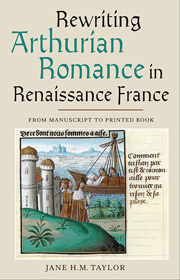Book contents
- Frontmatter
- Dedication
- Contents
- List of illustrations
- Acknowledgement
- Acknowledgements
- Abbreviations
- Introduction
- 1 Pierre sala, Poacher
- 2 ‘Books Printed Here’: The Business of the Print Shop
- 3 ‘A condition of survival’: Lancelot and Tristan
- 4 ‘Skimble-Skamble Stuff’: Meliadus, Merlin, Greaal
- 5 ‘Imperious Seductions’: Giglan and Perceval
- 6 ‘Satyric Scenes in Landscape style’: Amadis de Gaule
- 7 ‘Fruitlesse Historie’: Maugin's Tristan, Rigaud's Lancelot
- Afterword
- Appendix 1 Rough chronology of Publication
- Appendix 2 Sainct Greaal (1516) v. Vulgate Queste
- Appendix 3 Structure of the Roman de Giglan
- Bibliography
- Index
- Already Published
3 - ‘A condition of survival’: Lancelot and Tristan
Published online by Cambridge University Press: 05 March 2014
- Frontmatter
- Dedication
- Contents
- List of illustrations
- Acknowledgement
- Acknowledgements
- Abbreviations
- Introduction
- 1 Pierre sala, Poacher
- 2 ‘Books Printed Here’: The Business of the Print Shop
- 3 ‘A condition of survival’: Lancelot and Tristan
- 4 ‘Skimble-Skamble Stuff’: Meliadus, Merlin, Greaal
- 5 ‘Imperious Seductions’: Giglan and Perceval
- 6 ‘Satyric Scenes in Landscape style’: Amadis de Gaule
- 7 ‘Fruitlesse Historie’: Maugin's Tristan, Rigaud's Lancelot
- Afterword
- Appendix 1 Rough chronology of Publication
- Appendix 2 Sainct Greaal (1516) v. Vulgate Queste
- Appendix 3 Structure of the Roman de Giglan
- Bibliography
- Index
- Already Published
Summary
New readers make new texts […]
Change and adaptation are a
condition of survival.
In the late 1480s, less than twenty years after the first printing press in Paris opened for business, two, or perhaps three, publishers decided on what must have been a considerable gamble: the publication of the very first printed Arthurian romances. They chose the most popular, but also the most monumental: first, an integral Lancelot du Lac, including not just the Lancelot proper but also the Queste del saint Graal and La Mort le roi Artu, and second, a year or so later, a prose Tristan. A considerable gamble: the edition of Lancelot consists of two large folio volumes, more than 550 leaves in total, with, as we shall see, a pleasingly spacious page layout and sophisticated, specially commissioned, wood-block engravings; the Tristan, also in two volumes, also in folio, has a total of 336 leaves, and although it is unillustrated, the quality of the print and the layout do not suggest, at first sight, that the publishers' first concern was economy. The financial risk involved in these publications — the presses monopolised; the compositors, inkmen, typesetters, apprentices and journeymen printers and pressmen employed; the quantity of type required; the sheer cost of paper or vellum — is remarkable, and it is not surprising that the publishers of both romances sought to offset it by acting in consortium.
- Type
- Chapter
- Information
- Rewriting Arthurian Romance in Renaissance FrancePublishing from Manuscript to Book, pp. 61 - 90Publisher: Boydell & BrewerPrint publication year: 2014



